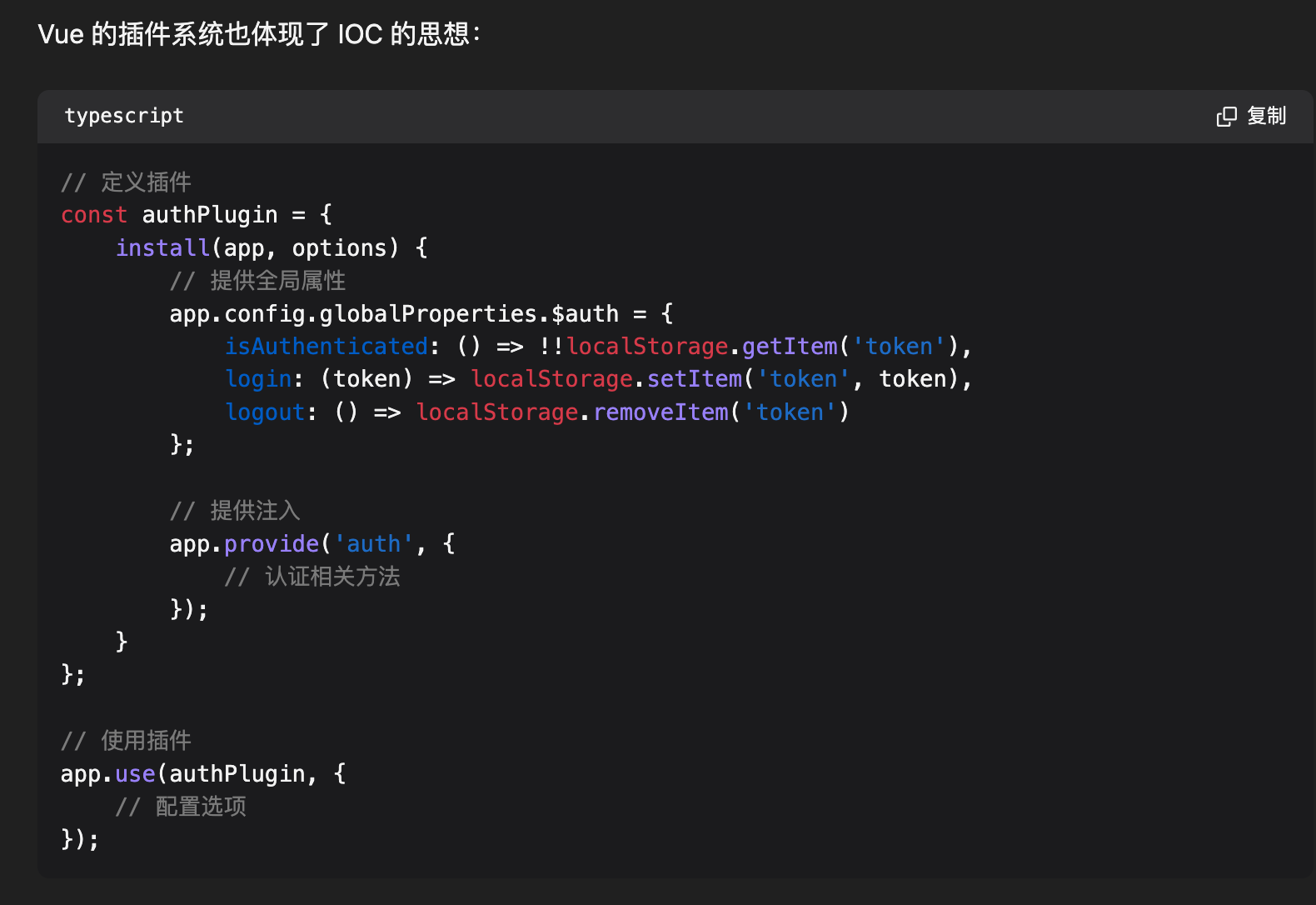编程思想&范式
#编程思想
目录
- 1. OOP (面向对象编程 Object-Oriented Programming)
- 2. 面向切面编程(AOP - Aspect Oriented Programming)
- 3. IOC(控制反转)
1. OOP (面向对象编程 Object-Oriented Programming)
- 封装(Encapsulation):
- 将数据和操作数据的方法绑定在一起,对外部隐藏具体实现细节
- 继承(Inheritance):
- 允许创建一个类作为另一个类的扩展,复用代码并建立类之间的层次关系
- 多态(Polymorphism):
- ==同一个操作可以作用于不同的对象上,产生不同的执行结果==
1.1. 多态例子:遥控器的
1.2. 定义遥控器类
- 遥控器 RemoteControl
- 电视遥控器 TVRemote extends RemoteControl
- 空调遥控器 ACRemote extends RemoteControl
- 音响遥控器 StereoRemote extends RemoteControl
// 定义一个遥控器接口
class RemoteControl {
pressButton() {
console.log('按下按钮');
}
}
// 电视遥控器
class TVRemote extends RemoteControl {
pressButton() {
console.log('电视开关切换了');
}
}
// 空调遥控器
class ACRemote extends RemoteControl {
pressButton() {
console.log('空调开始制冷了');
}
}
// 音响遥控器
class StereoRemote extends RemoteControl {
pressButton() {
console.log('音响开始播放音乐了');
}
}
1.2.1. 使用遥控器 → useRemote
// 使用遥控器
function useRemote(remote) {
remote.pressButton(); // 同样的动作,不同的表现
}
// 测试不同遥控器
const tvRemote = new TVRemote();
const acRemote = new ACRemote();
const stereoRemote = new StereoRemote();
useRemote(tvRemote); // 输出:电视开关切换了
useRemote(acRemote); // 输出:空调开始制冷了
useRemote(stereoRemote); // 输出:音响开始播放音乐了
1.3. Typescript 的多态:基于继承的多态 → 以 Animal 为例
1.3.1. 动物类
// 基类:动物
abstract class Animal {
name: string;
constructor(name: string) {
this.name = name;
}
// 抽象方法:必须由子类实现
abstract makeSound(): void;
// 共同方法
move(): void {
console.log(`${this.name} is moving`);
}
}
// 子类:狗
class Dog extends Animal {
makeSound(): void {
console.log(`${this.name} says: Woof!`);
}
fetch(): void {
console.log(`${this.name} is fetching the ball`);
}
}
// 子类:猫
class Cat extends Animal {
makeSound(): void {
console.log(`${this.name} says: Meow!`);
}
climb(): void {
console.log(`${this.name} is climbing`);
}
}
1.3.2. 多态使用
// 多态使用
function makeAnimalSound(animal: Animal) {
animal.makeSound(); // 调用的具体实现取决于实际对象类型
}
const dog = new Dog("Buddy");
const cat = new Cat("Whiskers");
makeAnimalSound(dog); // 输出: Buddy says: Woof!
makeAnimalSound(cat); // 输出: Whiskers says: Meow!
1.4. Typescript:基于接口、基于范型等的多态实现
2. 面向切面编程(AOP - Aspect Oriented Programming)
2.1. 定义
面向切面编程(AOP - Aspect Oriented Programming) 是一种编程范式,它允许我们:
- 将横切关注点(cross-cutting concerns)从主要业务逻辑中分离出来
- ==不修改原有代码的情况下增加新功能==
- TypeScript 的装饰器是实现 AOP(面向切面编程)的一种重要方式
- 常见的应用场景包括:
- 日志记录、性能统计、权限控制、错误处理等
2.2. React 和 Vue 中体现 AOP 的特性
- Vue 中使用
- 全局混入
mixin - 自定义指令
- 自定义 Hooks
- 插件系统
- 路由守卫
- 状态管理中间件
- 全局混入
- React 中使用
- ==高阶组件(HOC)==
- 装饰器
- 中间件
2.3. 使用 TypeScript 的装饰器是实现 AOP(面向切面编程)
以 前置通知(Before Advice)为例:
// 前置通知装饰器
function before(beforeFn: Function) {
return function(target: any, propertyKey: string, descriptor: PropertyDescriptor) {
// 保存原始方法
const originalMethod = descriptor.value;
// 创建新的方法
descriptor.value = function(...args: any[]) {
// 执行前置通知
beforeFn.apply(this, args);
// 执行原始方法
return originalMethod.apply(this, args);
};
return descriptor;
};
}
// 使用示例
class UserService {
@before(function(username: string) {
console.log(`准备创建用户: ${username}`);
})
createUser(username: string) {
console.log(`创建用户: ${username}`);
}
}
2.4. 基础函数装饰器:实现调用函数前和调用函数后的日志打印
// 基础函数装饰器
function decorator(fn) {
return function(...args) {
// 前置处理
console.log('Before function execution');
// 执行原函数
const result = fn.apply(this, args);
// 后置处理
console.log('After function execution');
return result;
}
}
// 使用示例
function greet(name) {
console.log(`Hello, ${name}!`);
}
// 装饰原函数
const decoratedGreet = decorator(greet);
// 调用装饰后的函数
decoratedGreet('John');
/* 输出:
Before function execution
Hello, John!
After function execution
*/
2.5. 示例:使用 Typescript 的装饰器实现==性能监控==
// 性能监控切面
function measurePerformance() {
return function(target: any, propertyKey: string, descriptor: PropertyDescriptor) {
const originalMethod = descriptor.value;
descriptor.value = async function(...args: any[]) {
const start = performance.now();
try {
return await originalMethod.apply(this, args);
} finally {
const end = performance.now();
console.log(`${propertyKey} 执行时间: ${end - start}ms`);
}
};
return descriptor;
};
}
class DataService {
@measurePerformance()
async fetchData() {
// 模拟异步操作
await new Promise(resolve => setTimeout(resolve, 1000));
return { data: 'some data' };
}
}
2.6. 示例:数据统计
const statistics = function(fn) {
return function() {
// 发送统计数据
sendStatistics();
return fn.apply(this, arguments);
}
}
2.7. 使用时机
- 当多个模块==共享相同的横切关注点==
- 需要动态添加或移除功能
- 需要==统一处理某些特定操作==
3. IOC(控制反转)
IOC(Inversion of Control)是一种设计原则,核心思想是:
- 将组件间的依赖关系从程序内部提到外部
- 将控制权从具体业务代码转移到统一的容器
- 用于解决组件之间的耦合问题
3.1. 使用好处
- 降低组件间的耦合度
- 提高代码的可测试性
- 更好的代码组织和维护
- 提供了统一的依赖管理方式
- 便于实现功能的替换和扩展
3.2. Vue 和 React 中的控制反转体现
- Vue
- provider 和 injection 等
- 虽然 Vue3 中的依赖注入机制不是传统意义上完整的 IOC 容器,但它确实体现了控制反转的思想,并且以一种更适合前端组件化开发的方式来实现
- Vue 的插件系统
- provider 和 injection 等
- React 的 Context API

